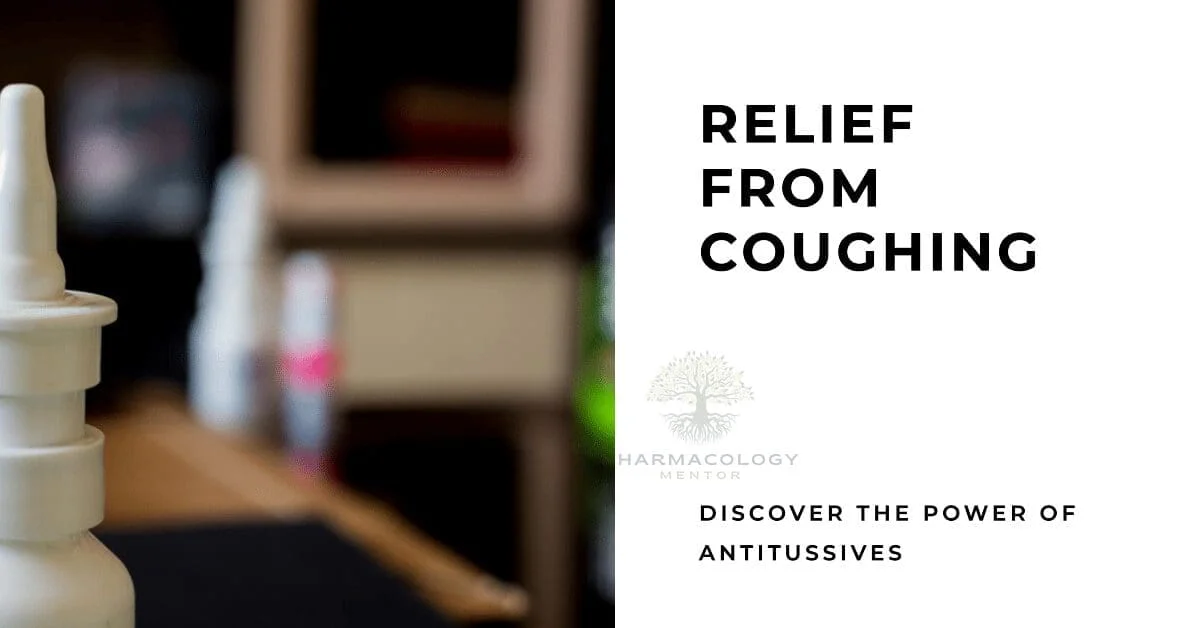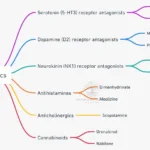Introduction
A cough is one of the most common clinical symptoms that prompts patients to seek medical care. Although it serves a critical protective role in clearing secretions, irritants, and pathogens from the airways, an excessive or persistent cough can compromise quality of life, disrupt daily activities, and impair sleep. The term “antitussives” refers to a broad class of medications that aim to suppress or reduce the frequency and severity of coughing.
Pharmacologically, cough suppression can be achieved through different mechanisms—some targeting the central cough control pathways, others attenuating peripheral triggers. But selecting an appropriate antitussive (or deciding whether to prescribe one at all) requires distinguishing the underlying etiology of the cough, as well as weighing the benefits of symptom relief against potential side effects.
This article provides an extensive review of the pharmacology of antitussives, structured to meet contemporary needs in clinical practice and research. Topics include the physiology of cough, classification of antitussive agents, mechanisms of action, clinical indications, adverse effects, and emerging trends. Consistent with best practices, the discussion incorporates insights from “Goodman & Gilman’s The Pharmacological Basis of Therapeutics” (13th Edition), “Katzung BG, Basic & Clinical Pharmacology” (15th Edition), and “Rang & Dale’s Pharmacology” (8th Edition).
Physiology of the Cough Reflex
The Protective Role of Cough
At its core, the cough reflex is a key protective mechanism that expels irritants, mucus, and foreign material from the upper and lower airways. In healthy physiology, this process is regulated by a complex interplay among afferent sensory pathways, central nervous system (CNS) cough centers, and efferent motor pathways to the diaphragm, chest wall, and abdominal muscles.
Sensory Afferents and Cough Receptors
Afferent signals originate from cough receptors in the larynx, trachea, and bronchi—often associated with mechanical and chemical sensitivity. Stimulation by irritants or inflammatory mediators triggers impulses that travel via the vagus nerve to the medulla. C-fibers, rapidly adapting receptors (RARs), and other specialized nerve endings respond to stimuli such as acid, heat, and particulates.
Central Integration
These afferent signals converge in the nucleus tractus solitarius (NTS) of the medulla, which, in turn, coordinates respiratory rhythm generation and reflex output together with other brainstem nuclei. The medullary “cough center” then integrates peripheral input with descending influences from higher centers to modulate the cough response.
Efferent Arm and Cough Generation
Efferent impulses pass through phrenic and spinal motor nerves to the respiratory musculature (diaphragm, intercostals, accessory muscles) as well as recurrent laryngeal branches controlling the larynx. A deep inspiratory effort followed by glottic closure and a forceful expiratory effort (with glottic opening) characterizes the explosive expulsion that defines cough.
Rationale for Antitussive Therapy
Cough is beneficial in clearing secretions and preventing infections. However, an excessive, persistent, or nonproductive cough can be detrimental. Conditions such as chronic bronchitis, postnasal drip, gastroesophageal reflux disease (GERD), respiratory infections, and asthma frequently cause troublesome coughing. By interrupting pathological cough pathways, antitussives can help reduce airway irritation, promote rest, and protect the upper airway from mechanical trauma.
Yet, not all coughs should be suppressed. In pneumonia or thick mucus plugging, for example, actively clearing secretions is essential. Hence, therapy decisions must consider cough etiology (productive vs. nonproductive), patient discomfort, and the risk-benefit balance of antitussives.
Classification of Antitussives
Central Antitussives
These agents act at the level of the cough center in the medulla, reducing the cough reflex. They include opioid and non-opioid drugs:
- Opioid Antitussives: Codeine, Hydrocodone, Pholcodine.
- Non-Opioid Antitussives: Dextromethorphan, Noscapine (in some regions), and other centrally acting synthetic compounds.
Peripheral Antitussives
Peripheral-acting agents may reduce cough by numbing or reducing the activation of airway cough receptors. Such agents include:
- Local Anesthetics: Benzonatate, which decreases the irritant transmission from stretch sensors in the lung and pleura.
- Pharyngeal Demulcents: Lozenges or syrups that soothe the throat’s mucosal surfaces, diminishing local triggers.
Mixed Mechanism Agents
Some drugs (e.g., certain antihistamines that reduce postnasal drip) may demonstrate both mild peripheral and central cough suppression. Expanding research also explores neuromodulators that act in cough pathways at multiple sites (central or peripheral).
Central-Acting Antitussives: Opioids
Codeine
Codeine is a prototypical opioid used historically as a cough suppressant. At therapeutic doses, it elevates the threshold for coughing in the medulla, possibly by binding mu-opioid receptors.
- Pharmacokinetics: Oral absorption is moderate; codeine is partially metabolized to morphine in the liver (via CYP2D6). Duration of action is around 4–6 hours.
- Clinical Use: Low-dose codeine formulations treat persistent, nonproductive cough. However, evidence for efficacy is mixed.
- Adverse Effects: Sedation, constipation, nausea, respiratory depression in overdoses, and potential for opioid dependency. Careful prescribing is essential.
- Regulatory Aspects: Many jurisdictions restrict codeine to prescription use due to abuse potential and variable metabolism (ultrarapid metabolizers).
Hydrocodone
Hydrocodone exerts stronger opioid potency than codeine. It is often formulated with other agents (like homatropine) to limit misuse.
- Mechanism: Mu-receptor agonism in the medulla to suppress cough reflex.
- Adverse Effects: More sedation, respiratory depression risk than codeine.
- Prescription Control: Strictly controlled, used typically for severe cough unresponsive to milder agents.
Pholcodine
Used in certain regions (Australia, parts of Europe), pholcodine is a long-acting opioid derivative with less analgesic potency, making it less prone to abuse.
- Advantages: Minimal sedation relative to codeine, less GI upset.
- Drawbacks: Efficacy remains debated; not universally available.
Central-Acting Antitussives: Non-Opioid Agents
Dextromethorphan (DXM)
A widely used, over-the-counter (OTC) non-opioid antitussive. Structurally related to levorphanol but lacking significant opioid analgesic effects.
- Mechanism: Dextromethorphan likely binds to sigma receptors in the medulla and may also inhibit the NMDA receptor, although its precise cough suppressant mechanism is multifactorial.
- Pharmacokinetics: Rapid oral absorption, metabolized by CYP2D6 to dextrorphan. Duration 3–6 hours.
- Clinical Use: For short-term relief of acute, nonproductive cough. Available in syrups, lozenges, capsules.
- Adverse Effects: Mild sedation, dizziness, GI upset. At high doses, potential for euphoria or dissociative states (abuse potential).
- Cautions: Patients on MAO inhibitors risk serotonin syndrome with high doses of dextromethorphan.
Noscapine
An alkaloid from opium poppy but lacking significant analgesic or euphoric properties. Rarely used in some Western countries but found internationally.
- Mechanism: Proposed mild suppression of medullary cough center, though less clearly delineated.
- Adverse Effects: Generally mild, may include sedation or GI upset.
- Availability: Regulations vary widely by country.
Other Non-Opioid Compounds
Occasionally, diphenhydramine or other first-generation H1-antihistamines are used for cough control given sedation and anticholinergic dryness. However, these are more beneficial if allergic rhinitis or postnasal drip underlies the cough.
Peripheral-Acting Antitussives
Benzonatate
Benzonatate (a tetracaine congener) exerts local anesthetic effects on stretch receptors in the respiratory passage and lung pleura.
- Mechanism: Reduces the afferent component of cough by diminishing receptor excitability.
- Clinical Use: Nonproductive cough relief, particularly with pleuritic irritation.
- Adverse Effects: Nausea, sedation, potential for numbness in the mouth if chewed or dissolved incorrectly.
- Cautions: Overdose can lead to CNS excitation, seizures, and arrhythmias—particularly in children.
Demulcents and Soothing Agents
Lozenges or syrups containing pectin, honey, or glycerin may provide symptomatic relief by forming a protective layer on pharyngeal mucosa, though direct efficacy data can be limited. They have minimal side effects, suitable for mild irritant coughs.
Additional Agents and Supportive Therapies
Though not classical “antitussives,” certain medication classes can reduce cough severity:
- Expectorants (e.g., Guaifenesin): Aim to loosen secretions, aiding clearance. This can indirectly diminish cough frequency if the impetus is thick mucus.
- Mucolytics (e.g., N-acetylcysteine): Break disulfide bonds in mucus, improving flow. Beneficial in conditions like COPD or bronchiectasis.
- Bronchodilators (e.g., Beta-2 agonists): In asthmatic or COPD patients, relieving bronchospasm can reduce cough triggers.
Managing underlying triggers—such as allergies, GERD, or infection—remains essential for long-term cough resolution.
Clinical Indications for Antitussives
Acute Cough
Short-term coughs from upper respiratory infections (URIs) often resolve spontaneously. Dextromethorphan or codeine-based OTC combos can help if the cough is disruptive, though guidelines emphasize limited usage and caution in children.
Chronic Cough
Persistent cough (lasting more than 8 weeks) requires thorough evaluation. After excluding or treating triggers (e.g., asthma, GERD, postnasal drip, smoking), an antitussive might be used as adjunct therapy if the cough remains burdensome. Low-dose opioids (like codeine or hydrocodone) can be considered in refractory situations under close supervision.
Cancer or Palliative Care
Patients with advanced cancer or end-stage disease may develop severe cough from lung metastases or chronic airway irritation. In such cases, potent antitussives (e.g., higher dose opioids) are often justified to improve comfort, with fewer concerns about dependency given the palliative context.
Special Populations: Pediatrics and Elderly
Use of antitussives in young children is often discouraged (particularly codeine or OTC cough mixtures) due to safety and lack of efficacy data. The elderly may be more prone to sedation, confusion, or falls from central antitussives, warranting lower dose starts and close monitoring.
Adverse Effects and Safety Considerations
Opioid-Related Effects
- Tolerance and Dependence: Chronic use fosters physical dependence. Abrupt cessation can trigger withdrawal.
- Respiratory Depression: Overdose risk in opioid-based cough remedies, especially with concurrent CNS depressants (benzodiazepines, alcohol).
- Sedation and Constipation: Even at moderate doses, sedation and GI motility reduction are common.
Non-Opioid CNS Reactions
- Dextromethorphan: At very high doses, can cause dissociation, hallucinations (popularized in recreational misuse).
- Sedation: Some central antitussives still produce mild sedation, though typically less than opioids.
- Interaction: Potential for serotonin syndrome if combined with SSRIs, MAO inhibitors.
Peripheral Agent Risks
- Benzonatate: Overdose can lead to severe CNS excitement or cardiovascular complications, especially in accidental pediatric ingestion. Numbness of the oropharynx can precipitate choking if capsules are bitten.
Allergic Reactions & Hypersensitivities
Excipients in cough formulas or certain antitussives can provoke rash or anaphylaxis in susceptible individuals. Checking for allergies is prudent, particularly with multi-ingredient OTC products.
Placebo Effect and Efficacy Debates
Research consistently shows that cough can be influenced by multiple factors—some physiological, others psychological. A significant placebo effect often accompanies antitussive therapy, especially in benign self-limited conditions. Many trials yield equivocal results about the superior efficacy of codeine or dextromethorphan over placebo for acute URI cough.Still, patients might experience subjective relief, making short-term usage acceptable if the patient is significantly distressed and the medication is used responsibly.
Emerging Therapies and Novel Targets
TRP Channel Modulators
Transient receptor potential (TRP) channels (like TRPV1, TRPA1) in airway sensory nerves respond to thermal, chemical, and mechanical stimuli. Investigational drugs that block TRP channels could dampen peripheral cough triggers without the sedation or dependence potentials of opioids.
P2X3 Antagonists
P2X3 receptors, found on sensory afferents in the airway, are implicated in chronic refractory cough. Molecules targeting P2X3 (e.g., gefapixant) show promise in late-stage clinical trials for significantly reducing cough frequency.
NK1 Receptor Antagonists
Neurokinin-1 (NK1) and substance P are involved in airway inflammation and cough reflex pathways. Early-phase studies test whether blocking NK1 can mitigate chronic cough in patients with conditions like idiopathic pulmonary fibrosis or advanced cancer.
GABA-B Agonists
Baclofen, a GABA-B agonist, has been explored for central cough suppression. Though sedation limits usage, analogs with improved side effect profiles might have future potential.
Gene Therapy and Personalized Approaches
Evolving research proposes that subpopulations of chronic cough patients have distinct molecular triggers. Genetic or transcriptomic profiling might guide targeted therapy in the future, akin to precision medicine models.
Clinical Decision-Making: When to Use Antitussives
Symptomatic vs. Curative Intent
An antitussive rarely addresses the root cause (e.g., infection, reflux) but can provide symptomatic relief where cough is unproductive and disruptive. Therefore, thorough diagnostic workup is crucial. If the cough is “protective” (like in pneumonia or CF with thick sputum), routine suppression might hinder clearance.
Risk-Benefit Assessment
For mild or acute cough from a viral URI, nonpharmacological measures (hydration, humidification, honey in children over 1 year) can be adequate. Antitussives might be reserved for nighttime relief if cough disrupts sleep. In chronic scenarios, potential adverse effects (opioid dependence, sedation, respiratory depression) necessitate cautious prescription.
Pediatric and Geriatric Nuances
- Pediatrics: The U.S. FDA advises caution against most OTC cough products under 2 years of age. For older children, carefully selected non-opioid options (like dextromethorphan) may be used short-term.
- Geriatrics: Lower initial doses, vigilance for confusion, sedation, orthostatic hypotension. Interaction with existing polypharmacy is common.
Combination Products
Cough medications often come mixed with decongestants, antihistamines, or expectorants. These multi-ingredient formulas can be convenient but risk unnecessary drug exposure and complicated side-effect profiles. A single-agent approach is often preferable, tailoring to the specific symptom or underlying cause.
Special Topics: Antitussives in Opioid Epidemic Context
With rising opioid misuse and overdose, regulatory scrutiny extends to cough syrups containing codeine or hydrocodone. Guidelines typically restrict them to short-term usage for severe cough unresponsive to other measures. Some regions have changed codeine cough syrup from over-the-counter (OTC) status to prescription-only, requiring ID checks and limiting refills to curb abuse.
Future Directions for Research
Biomarker-Driven Therapy
Advanced diagnostic techniques—such as lung imaging, cough frequency counters, or inflammatory biomarkers—may help classify cough subtypes (allergic, neuropathic, idiopathic) to match them with targeted interventions.
Non-Pharmacological Modalities
Behavioral cough suppression therapies, speech therapy, or physiotherapy for specialized conditions (e.g., hyperventilation syndrome, vocal cord dysfunction) can potentially reduce reliance on pharmacotherapy.
Harmonizing Guidelines
Professional bodies like the American College of Chest Physicians (ACCP) frequently update guidelines on chronic cough management, advocating for systematic “cough pathways.” More robust, placebo-controlled trials are needed to confirm the effectiveness of novel antitussives in distinct patient populations.
Practical Tips for Healthcare Providers
- Identify Etiology: Chronic coughs (>8 weeks) demand thorough evaluation of possible triggers (postnasal drip, GERD, bronchitis, asthma, smoking).
- Assess Productivity: Productive coughs clearing secretions are usually essential; blocking them can be detrimental.
- Start with Non-Drug Measures: Ensure hydration, humidity, avoidance of irritants, and address underlying conditions.
- Use Evidence-Based Agents: If an antitussive is indicated, select carefully (e.g., short course of dextromethorphan for acute, mild cough).
- Monitor for Side Effects: In particular, opioids require vigilance for sedation, respiratory depression, and misuse potential.
- Avoid Pediatric OTC Combinations: If absolutely needed, consider single-ingredient and counsel on dosing.
- Follow Up: Reevaluate cough persistence and refine the approach, including further investigations if no improvement.
Conclusion
Antitussives encompass a diverse array of pharmacological strategies aimed at suppressing troublesome cough. They can act centrally (via opioid or non-opioid pathways) or peripherally (by reducing stimulus at airway receptors). While they offer symptomatic relief in acute or chronic cough syndromes, their prescription must be tailored to the underlying cause, balancing the protective function of cough against patient discomfort.
Opioid antitussives, such as codeine and hydrocodone, remain an option for moderate to severe cough control but carry a clear risk of dependence and respiratory depression. Dextromethorphan, a non-opioid central agent, is popular in OTC formulations, though high doses can be misused. Benzonatate exemplifies a peripheral approach, dampening airway receptor sensitivity.
Given the heterogeneity of cough etiologies, an evidence-based evaluation of each patient’s condition is essential. Nonpharmacological measures, short-term use of established agents, and caution in pediatric and geriatric populations help ensure safety. Ongoing research into TRP channel antagonists, P2X3 receptor blockers, and innovative central modulators foreshadows the next generation of targeted antitussive therapies. Overarching these developments is an evolving recognition that, while antitussives can help, they seldom address root causes; clinicians must treat the underlying pathology for enduring relief.
In a healthcare landscape shaped by concerns about opioids and limited efficacy data for many established cough remedies, prescribing antitussives requires astute clinical judgment and adherence to guidelines. By maintaining awareness of the pharmacodynamics, side effects, and legitimate indications for these agents, healthcare professionals can effectively mitigate cough-related distress while prioritizing patient safety and quality of life.
Book Citations
- Goodman & Gilman’s The Pharmacological Basis of Therapeutics, 13th Edition.
- Katzung BG, Basic & Clinical Pharmacology, 15th Edition.
- Rang HP, Dale MM, Rang & Dale’s Pharmacology, 8th Edition.
📚 AI Pharma Quiz Generator
🎉 Quiz Results
Medical Disclaimer
The medical information on this post is for general educational purposes only and is provided by Pharmacology Mentor. While we strive to keep content current and accurate, Pharmacology Mentor makes no representations or warranties, express or implied, regarding the completeness, accuracy, reliability, suitability, or availability of the post, the website, or any information, products, services, or related graphics for any purpose. This content is not a substitute for professional medical advice, diagnosis, or treatment; always seek the advice of your physician or other qualified health provider with any questions you may have regarding a medical condition and never disregard or delay seeking professional advice because of something you have read here. Reliance on any information provided is solely at your own risk.









